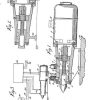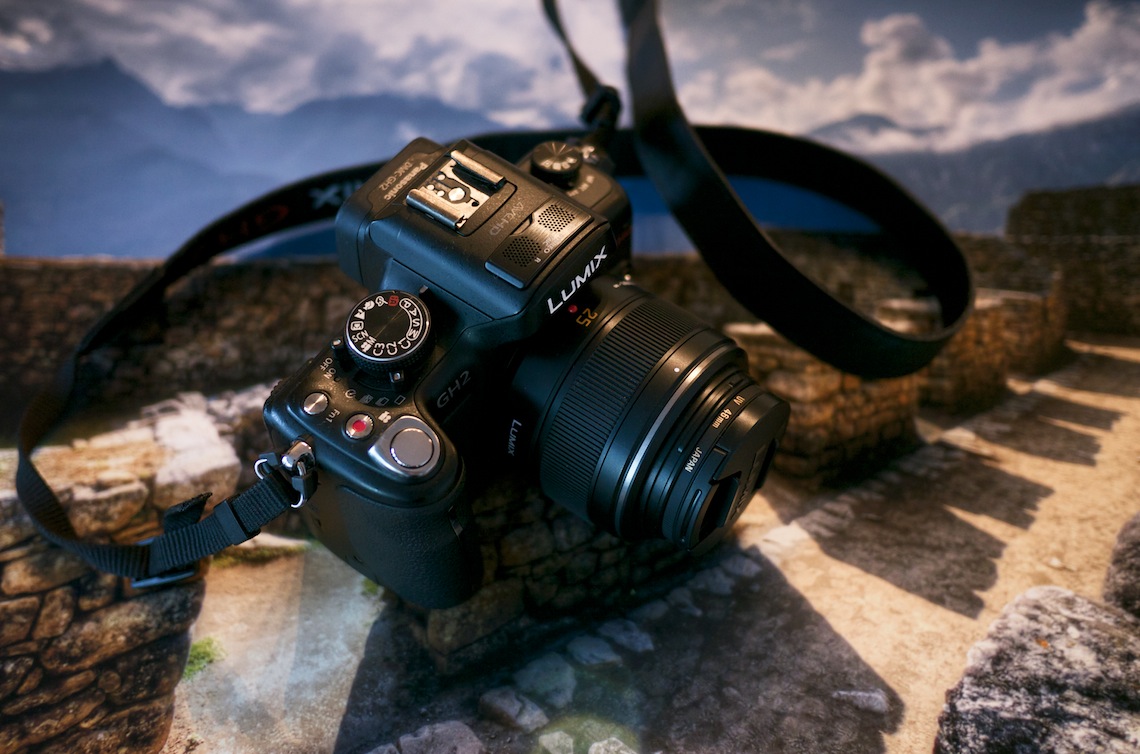

The real test of a travelling with a camera, 7 days clattering in a CamelBak
This review is an update to a
previous article
since then I’ve upgraded to a GH2 with some new glass.
For this review, like any review, which is oft forgotten on the ‘net you need context. My context for taking photos is, I rarely take a camera out on the town (where more pocketability would be needed) nor am I photographer shooting for large format print. I am into adventure, I like playing with controls – the only time I set anything to Auto is when I hand the camera to someone else, I like HDR (therefore bracketing is required), I like to go places, I need something light weight, with good manual controls, that has varied options in glass – as I like both wide angles for landscape work, fast for shallow depth of field, and large zooms for wildlife and nature. The GH2 is a perfect fit. So if that’s your cup of tea this camera is likely for you, if not.. well read on anyway. First off – four thirds system, I’m not going to recreate wikipedia here ..
more about Micro Four Thirds
What is the GH2?
The GH2 is arguable the most ‘pro’ of the MFT camera range, including both Olympus and Panasonic, and a successor to the GH1 (which I had previously). It has all of the manual controls you could possibly want and a plethora of features packed into it’s tiny little body, along with a few functional enhancements over the GH1. It has the largest sensor @ 18MP total area (although in practise, slightly less is used for capturing light), and is extremely hackable for video work. In comparison the other MFT cameras tend to trade off features for size. I personally like the grip style form factor of the GH2 vs the more ‘compact’ style cameras like the GF1 as I just can’t get used to them in the store. The GH2 also has a couple of welcome enhancements over the GH1, including moving the dial selector rear of the body than the front.
Like all MFT camera’s the lenses are interchangeable between Olympus and Panasonic, so there’s a good and growing selection of lenses, and if you’re really desparate you can get other adaptors to other mounts. Right now I’ve got a good selection (7-14mm, 20mm, 25mm, 14-140mm and a four thirds 70-300mm), I’m only really hanging out for the fast zooms to become available, I’m pretty much ‘done’ otherwise in the lens department.
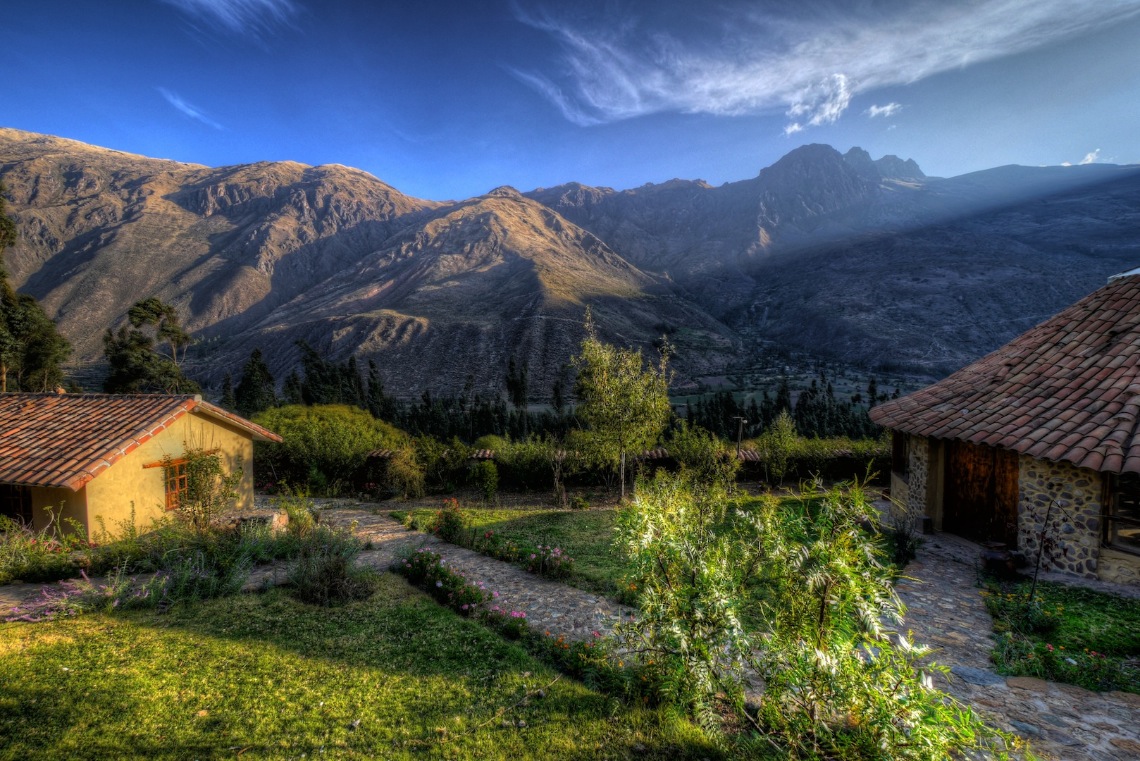
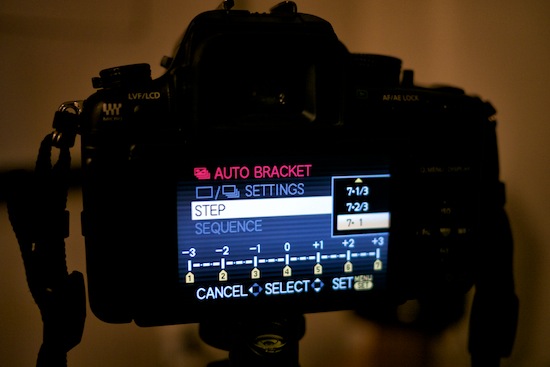
Bracketing settings, a must have. 7 at 1 stop increments max.
“The only good camera, is the one you have with you”
This to me sums up micro four thirds in one phrase. I want all of the controls, for example exposure bracketing, and a sensor good enough to take big prints off, but in a package I can take places. How often have you heard “I didn’t bring it”, “it’s a pain in the ass”, “ugh”. So you’ve got to wonder how many people actually carry their big DSLR’s everywhere ? Those big DSLRs are not a lot of good sitting at home in a drawer when the picture is right in front of you. This is the single biggest advantage of the MFT system.
I spent 7 days on a Mountain Bike in Peru, with my GH2, and usually my favourite lens the 7-14mm, nestled in the top of my CamelBak Mule. When I say nestled, I really mean ‘just enough room to put an elongated grapefruit’. Even at altitude, and when I was dog tired, it still didn’t weigh enough to be an issue – I just packed it away every single day. The results were amazing
photo essay on Peru here
The telling fact, was someone else on the trip, did have a DSLR, with a Clik backpack, specially made to mtb with, took his camera one day, and then that was it – it stayed behind.
The body alone, weighs nearly half that of a suitably high end DSLR. Then the lenses, through MFT’s optics are half the focal length of standard DSLR’s.
From the experts
I am an enthusiast or this newly title ‘prosumer’. Thus as said before, this review is in context. If you want an expert opnion with it all broken down in ultimate camera-nerd detail then go to these sites below.
CSM Image Quality – Luminous Landscape
A detailed look at image quality on smaller sensors vs Digital SLR sensors
On Safari – Luminous Landscape
this mirrored my experience with the GH1. Why you would consider a massive DSLR with equally massive lenses….
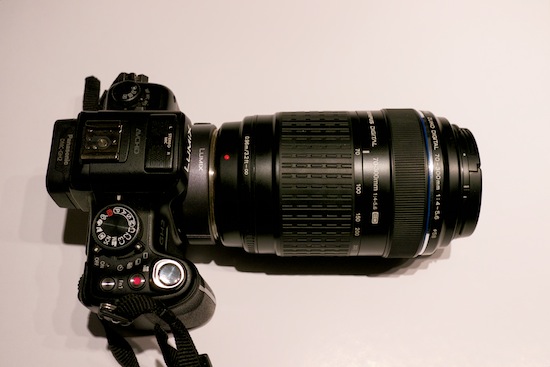
GH2 with a Four Thirds Adaptor, and the Olympus 70-300mm.
Doubling Focal Length
I can’t overstate this enough, if you are taking nature photos of critters large or small, big zooms are the order of the day. In DSLR land – this is usually in-accessible as they are ridicously expensive, and ridiculously large. However in MFT, because the effective focal length is doubled, that 300mm lens suddenly becomes 600mm. This is a huge factor (although realise in reverse if you want to go wide, things get tricky). If you’re not shooting for a billboard or print production, which I guess 99.99% of camera buyers are, take this next bit into consideration.
A 600mm regular DSLR lens. Well, first there’s no such thing as a regular 600mm lens, they’re a) massive and b) expensive. You’re talking $8’000+ for a lens. So lets peg it back to a say 500mm zoom lens. Taking a Sigma, not a top of the line model Canon or Nikon, sits around $1’000USD, weighs 2kg, and is 25cm long.
Conversely lets take the Panasonic 100-300mm lens. It weighs 0.5kg, and is 12cm long, and costs $600. So you’ve got a tiny lens that’s not expensive, that you can take places.
When I went on this trip to Africa, at that stage the 300mm Panny hadn’t come out, so I bought a 70-300mm Olympus, with a Four Thirds adaptor. Best decision ever. I’d never shot with such a long lens before. Amazing results…
Shot with a cheap Olympus 70-300mm four thirds lens that I got on special.
Upgrading from the GH1
General Performance
improved over the GH1. Shot to shot times quicker and shutter lag reduced, more pixels.
The charger
thank you Panasonic! A wall plugin charger without all the cables. For travelling this was one of the biggest pains in the a___ with the GH1. Not to be underestimated. Oh yeah, you want to know about the *camera*.
Finger dial, became a thumb dial
thank you panasonic!. Ergonomically much better.
touch to shoot
now, this is a weird one. I thought this would be totally gimmicky. But in a crowded room, if you want to focus and shoot on an individual just touch the screen. Good for quick fire ‘bang bang bang’ shots.
Pros
Olympus and Panasonic
Both have the MFT standard, which means two companies to buy lenses from…
Light weight & Small Size
Obviously. Tiny lenses and tiny body. Bam !
Controls
Everything just feels intuitive. Or maybe I’ve been with Panasonic since the LX-3. It just all seems to work nicely. All the controls are well placed – the major gripe I had with the GH1, thumbdial on the front, is now on the rear.
Durability
I barely survived 7 days of All Mountain riding in Peru. The camera passed with flying colours, it’s still focusing sharply and nothing untoward is happening. It officially had 24 hours total ride time juggling around in a Camelbak…
Video quality
Off the charts. Really insanely good for a little prosumer device, and if you start hacking it… well…
Driftwood 176mbit GOP1 GH2VK
Cons
Slightly smaller sensor
less dynamic range and ultimate pixel count compared to a full frame sensor
Limited (mfr) lenses
compared to say a Canon or Nikon body, you don’t have ultimate lens selection. But then if you’re not a commerical photographer, do you need to…
Paying $90
for a remote shutter release. C’mon it’s a button and a cable. Really Panasonic ??
Cost
Not cheap. It’s not really possible to do apples to apples, but it’s getting up there price wise.



